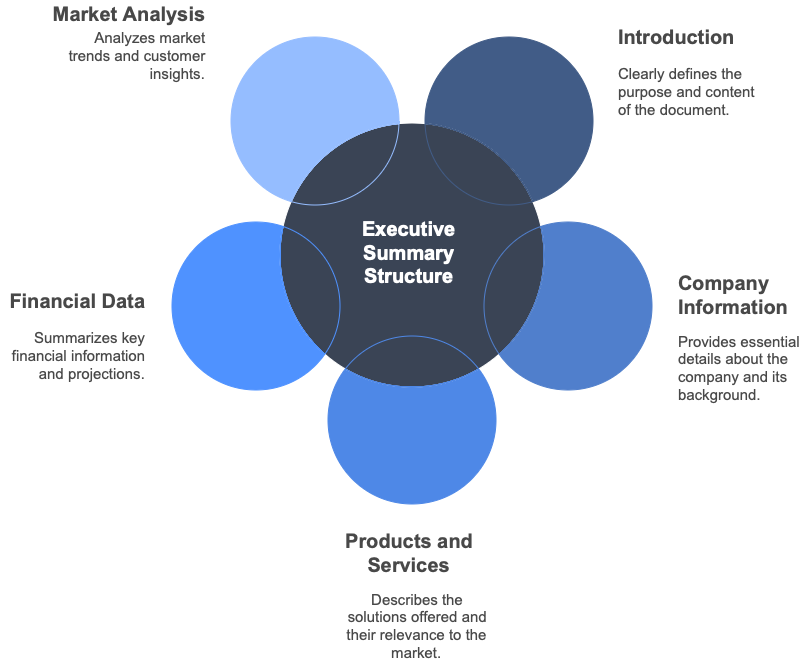Project Management with a Bit of Magic
Plan, manage, and deliver projects efficiently. Merlin Project for macOS and iOS

A good executive summary saves the reader time and motivates him to delve deeper into the topic of the document. Read what you should keep in mind when writing.
The information age has changed the way business plans, project proposals and research reports are distributed and consumed. Today, more and more readers are seeing this content digitally on a screen. And in today's fast-moving world, it is precisely this content that is often lacking.
This method of content consumption increases the risk that important information is lost due to the scanning and scrolling behavior of an online audience.
It is therefore all the more important to create a short and concise summary of the document and give it to the reader as an 'executive summary'.
What Is an Executive Summary?
Why Should you Write an Executive Summary?
How to Write an Executive Summary
What Should Be Included in the Executive Summary?
What You Should Look out for in the Summary
How Do I End an Executive Summary?
Use Templates to List Everything Important in the Executive Summary
⬇️ Bonus: Download our Free Executive Summary Template
The executive summary has its name from the fact that it was necessary to attract the attention of top management. Executive staff did not have time to read every word in every document. They need to use their time efficiently. Surely, the paperless office is spared from high stacks of business documents to be read. Depending on the industry, these can be business documents (business plan, project proposal, report) or long articles or documents that are common in research-oriented communities and universities.
Nevertheless, working through an extensive text, combined with acquiring an understanding of technical terminology, in order to then make a decision based on it, remains very time-consuming. If a negative decision is made, it is often considered a waste of time, which creates a high hurdle for dealing with texts at all and not simply rejecting them from the outset. For this reason, it is helpful to first be able to deal with a summary of the content and only to get into the details if there is further interest.
Use the summary to create a business case, support a position, or tell a story. After reading the summary, the reader should know how the topic affects him or her, how it benefits his or her work, projects or company.
Various industries also use summaries as a means of communication, including healthcare, education, government, technology, real estate, finance, law, the non-profit sector and more. An executive summary is not just for one type of information, it appears in a variety of use cases, for example:
An executive summary summarizes the content of a document clearly, concisely (max. 2 pages long) and concisely and should contain the essential information, the recommendations, the results and the financial statements. It saves the reader time in capturing the topic, but should arouse their curiosity by providing an overview of the information and objectives, i.e. the purpose of the summary document.
Creating a summary requires more than just cutting and pasting important snippets of information from the business document or report. It may be the only part your audience reads. So take the time to make the summary meaningful and valuable to the reader.
Before you start writing, you should ask yourself the following critical questions:
Who depends on the information?
When you write the summary, you decide who to contact and what critical information the target group needs. What do they need to know to make a decision? What do they already know? Do you have a specific customer you want to reach with your message or story? If you have this audience in mind when you write the summary, the story you tell about your company, your project or your proposal will also reach them.
What is the objective?
It is true that an executive summary summarizes material information from the text of your report or proposal, that is its function, not its purpose. Write the summary to your audience and add the critical information to help you achieve your goal of creating the document. What does the reader need to understand? Is the goal to recommend changes based on the results of your research? What needs to be done for the project plan to be successful based on your proposal? Let your objectives determine the content and context of your summary.
What do you recommend?
Use the summary to draw conclusions and make recommendations to the reader. If your report needs to be changed, use the summary to recommend the actions you supported. List the benefits of your product or service, or the solutions that you explain in more detail in the document as a whole. Ultimately, you want to show the reader what action they need to take: Make your recommendations clear in the abstract.
How do you make an impression?
The summary must leave an impression because it may be the only part of the material that is read. A good impression may encourage the reader to continue reading or to take action. Think about how you'll shape the message, organize the sections of your summary, or present the research to set yourself apart from the crowd.

You determine the components of each executive summary you write based on the reason for writing and your target audience. For example, an external audience business plan will include financial information and details about a company's size and scope; start-ups looking for financing opportunities; and investors will highlight specific financial requirements and their impact on business strategy. Executive summaries will vary in terms of the content they cover.
Introduction:
Start the summary of the document by clearly defining its purpose and content. How you formulate this section depends on the desired result for the reader or audience. It should immediately find value in the information you present. The details contained in the introduction should therefore captivate and capture the reader's attention.
Company information:
Inform the reader about your company name including contact information and location, provide a description of your activity and purpose, as well as the size and scope of your business. In some cases, the summary will introduce the founders, investors and management. It may include background information from anyone describing past industry or start-up experiences or historical contexts about the current situation of the business. When used in a presentation or research report, introduce the team that presents or is responsible for the results of the report.
Products and Services:
Describe the problem you are solving or the need you can meet. For a report you can highlight here what you have researched and what the reader should know about your results. In a project proposal, state what you want to achieve and what you need to make it successful. For marketing plans or product presentations, tell the reader why your service or product is relevant at this point, who your customers are and where the customer benefit lies.
Financial Data:
The summary could summarize important financial data that is relevant to the reader, or data that supports your research. If the purpose is to secure funding, indicate the specific amount you need. Make sure you provide the context for the financial data or any number you highlight in the abstract. Show the financial development over the next 3 years and mention the key figures.
Market Analysis:
The executive summary of a business plan could tell you why the market is attractive and what important characteristics the industry has. Consider questions like: Is there a five-year plan for this market? How do you plan to increase your customer base and market share? What does your research about your customers tell you that the reader should know?
Competitive Analysis:
This section should answer the following questions:
Conclusions:
Summarize your results, the problem discussed and the solution or project and the proposed work. If there is a decision that the reader needs to make, point it out. Make the results obvious, but make curious about the overall content.
Be brief!
The summary is intended to save time. Therefore, make sure to keep the text short and limit yourself to a maximum length of 2 pages. On no more than two pages you should try to arouse the reader's interest.
Do not use specialized jargon
Write your summary in such a way that a person not familiar with the subject understands it. Your audience is not always familiar with the subject, so special technical terms are not helpful. Also make sure that you avoid lengthy and imprecise wording.
Make a realistic assessment
Stay realistic in formulating your summary. Sentences like "infinite potential" and "massive profit increase" seem unprofessional. End the executive summary with a positive outlook.
Position in the entire document
Although the executive summary is written after the business document (business plan, project proposal, report), long article or document has been created, the summary is still written at the beginning of the complete document.
Although the summary starts a document, it concludes that it can be stand-alone from the rest of the content and yet of value. Use the conclusion to summarize your findings, make recommendations, and suggest solutions to the problem. If there is a decision you want the reader to make, ask for a call to action in this section. When summarizing a research report, summarize the results and research methods used to complete the work. Make the results or recommendations visible, but leave enough out to encourage the audience to read on. Close the summary with a strong statement or transition that sets the theme or central message to the story you are telling in the report or proposal.
No matter which program you work with - templates can be created and reused anywhere. They help you not to forget important information in the summary.
Why not create your Executive Summary as a mind map? Unusual formats like this attract the attention of your target audience. With our template, you can summarize the main points of your document on a one-page mind map.
But also with the often used Office suite of Microsoft meaningful executive summaries can be created. Short sections and structure points keep the document short and concise and provide the reader with the most important information of the main document. Here, too, inserted graphics and diagrams can attract the reader's attention.
Download a free template for an executive summary: Merlin Project Mind Map | Word | Excel.

Your ideas, our magic – make projects easy! Test now 30 days for free.
